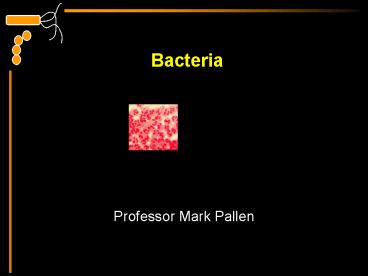Bacteria - PowerPoint PPT Presentation
1 / 31
Title:
Bacteria
Description:
Meningitis, Food poisoning. Mad cow disease. Emerging infections. Hospital Infection ... Staphylococcus aureus. coagulase-positive. Staph. epidermidis ... – PowerPoint PPT presentation
Number of Views:62
Avg rating:3.0/5.0
Title: Bacteria
1
Bacteria
- Professor Mark Pallen
2
Outline
- Importance of bacteria
- Nature of bacteria
- Classification of bacteria
3
Importance of Bacteria
- Life is microbial! (to the first approximation)
- Micro-organisms colonise every environment on
earth - gt80 of lifes history was bacterial
- You have more bacterial cells than human cells
- Microbes play a key role in the biosphere
- Pathogenic microbes globally are the most
important cause of human disease and death
4
Importance of Infection
- Decisive role in history
- Still major cause of death and misery worldwide
- Public anxieties
- Meningitis, Food poisoning
- Mad cow disease
- Emerging infections
- Hospital Infection
- Antibiotic-Resistant Superbugs
5
Microbes in History
6
Microbes in History
7
Microbes in the News
8
Microbes in the News
9
Microbes in the News
10
Microbes in the News
11
Differences between Bacterial and Human Cells
- Bacterial cells
- No nucleus
- No intracellular organelles (but ribosomes)
- No introns (nearly)
- No junk DNA
- Plasmids, bacteriophage
- Human cells
- Nucleus
- Intracellular organelles (ribosomes subtly
different) - Introns
- Lots of junk DNA
- Viruses
12
Tree of Life
13
Size matters
Bacterial cells
Animal cell
1 micron
10 microns
14
Bacterial cells
15
Differences between bacteria and viruses
- Viruses
- Obligate intracellular parasites
- No ribosomes
- DNA or RNA, not both
- seen by EM
- 10-100s of genes
- Tangled phylogeny
- Bacteria
- Usually free-living, but can be parasites
- Ribosomes
- DNA and RNA
- seen by LM
- 100s-1000s of genes
- Natural phylogeny
16
The Gram stain procedure
Developed in 1884 by the Danish physician Hans
Christian Gram An important tool in bacterial
taxonomy, distinguishing so-called Gram-positive
bacteria, which remain coloured after the
staining procedure, from Gram-negative bacteria,
which do not retain dye and need to be
counter-stained. Can be applied to pure cultures
of bacteria or to clinical specimens
Top Pure culture of E. coli (Gram-negative
rods) Bottom Neisseria gonorrhoeae in a smear of
urethral pus (Gram-negative cocci, with pus cells)
17
The Gram Stain
Gram's
Crystal
iodine
violet
Decolorise with
acetone
Gram-positives
appear purple
Counterstain with
e.g. methyl red
Gram-negatives
appear pink
18
Gram-positive rods
Gram-positive cocci
Gram-negative rods
Gram-negative cocci
19
Anaerobic
Anaerobic
Gram-positive rods
Gram-positive cocci
Gram-positive
cocci
Anaerobic
Anaerobic
Gram-negative rods
Gram-negative cocci
20
Bacterial Growth
- Solid media or liquid media
- Agar plates, slopes, broth culture
- Atmosphere
- Aerobic, anaerobic or microaerophilic
- Facultative or obligate anaerobes
- Usually at 37 degrees C
- Most clinically important bacteria grow
overnight, or within a few days - Mycobacteria can take months
- Some can not be grown
21
Gram-Negative Rods
- Enteric Bacteria
- E. coli
- Salmonella
- Shigella
- Yersinia
- Pseudomonas
- Proteus
- Vibrio cholerae
- Klebsiella pneumoniae
22
Gram-Negative Rods
- Fastidious GNRs
- Bordetella pertussis
- Haemophilus influenzae
- Campylobacter jejuni
- Helicobacter pylori
- Legionella pneumophila
- Anaerobic GNRs
- Bacteroides fragilis
- Fusobacterium
23
Gram-Negative Cocci
- Neisseria gonorrhoeae
- The Gonococcus
- Neisseria meningitidis
- The Meningococcus
- Both Gram-negative intracellular diplococci
24
Gram-positive Cocci
- Staphylococci
- Catalase-positive
- Gram-positive cocci in clusters
- Staphylococcus aureus
- coagulase-positive
- Staph. epidermidis
- and other coagulase negative staphylococci
25
Gram-Positive Cocci
- Streptococci
- Catalase-negative
- Gram-positive cocci in chains or pairs
- Strep. pyogenes
- Strep. pneumoniae
- Viridans-type streps
- Enterococcus faecalis
26
Gram-Positive Rods
- Clostridia
- Anaerobes
- C.perfringens
- C. tetani
- C. botulinum
- C. difficile
- Bacillus cereus
- Aerobe
- Listeria monocytogenes
- Faculative anaerobe
27
Non-Gram-stainable bacteria
- Unusual gram-positives
- Spirochaetes
- Obligate intra-cellular bacteria
28
Unusual Gram-positives
- Mycoplasmas
- Smallest free-living organisms
- No cell wall
- M. pneumonia, M. genitalium
- Mycobacteria
- Acid-fast bacilli, stained by Ziehl-Neelsen stain
- M. tuberculosis
- M. leprae
- M. avium
29
Spirochaetes
- Thin spiral bacteria
- Viewable by phase-contrast microscopy or silver
stain - Treponema pallidum
- Borrelia burgdorferi
- Leptospira
30
Obligate intracellular bacteria
- Rickettsia
- Coxiella burneti
- Chlamydias
- C. trachomatis
- C. pneumoniae
- C. psittaci
31
Outline
- Importance of bacteria
- Nature of bacteria
- Classification of bacteria
- Gram-positive versus Gram-negative
- Rods and Cocci
- Aerobic versus anaerobic































